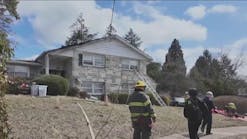California Firefighters, Vets Team Up to Save Bull
Source The Sacramento Bee, Calif.
The rescue of a bull from a cistern Tuesday night was successful in large part because of a partnership between Sacramento Metro firefighters and UC Davis veterinarians.
The two groups have trained together and shared knowledge: the vets offering expertise on animal traits and the firefighters teaching about rescuing people and animals from dire situations.
"They trained us on animal behavior," said Capt. Tom Neville of the Sacramento Metropolitan Fire District. "We taught them how to do the rescue part. Together, we pull these rescues off."
The 1,500-pound rodeo bull fell into the cistern that supplies water to livestock troughs in brown-colored pasture along Old Placerville Road near White Rock Road.
The concrete structure that trapped the bull was deep enough that the animal couldn't get out. There he stayed until an off-duty California Highway Patrol officer driving by noticed the bull's head peaking over the sides of the cistern, according to Neville.
The CHP officer's call brought out various emergency personnel, including the Heavy Rescue Company from Metro Fire about 9 p.m. Tuesday.
"We rescue folks out of collapsed structures, whether it be concrete or wood," said Neville. "We have all the tools to do that. We do trench, confined, water and rope rescue. If somebody gets trapped we deal with it."
Along the way, the rescue company has trained with the UC Davis Veterinary School. The school has a Veterinary Emergency Response team to assist with animal rescues.
The firefighters and veterinarians have worked together to rescue a horse near Placerville and conducted drills on lifting animals from tight situations. The firefighters use ropes and slings to lift people and animals who cannot extricate themselves from situations.
When they arrived, firefighters found the 2-year-old bull up on his hind legs. His front hooves were up on the side of the cistern and his head above the water. The well had about 8 feet of water in it, Neville estimated.
"We saw a bull's head sticking out, periscoping if you will, pushing off on his hind legs, and then going back down," said Neville. "He was very anxious, wide-eyed. He wanted out."
UC Davis veterinarian Cheryl Ellis evaluated the animal and developed a plan with Neville to secure the bull by the horns to a tow truck.
The animal was sedated, with Ellis giving enough sedation to quiet the bull but not so much that it would become dopey and slip below the water.
A sling was placed under the bull's upper torso. As a tow truck lifted the animal, the sling, slipping on the wet bull, tightened onto one of its front legs and head.
Neville decided to keep the tow truck lifting because he didn't want to set the bull back down in the cistern. The bull was placed on the ground and pulled a good distance away from the gathered media and rescue workers.
"We did the old 'untie and run for our lives,' " said Neville. "We were all figuring who was the slowest one. At the age of 49, I was the slow guy."
Eventually, the bull staggered around, and then "went down the hill to join his buddies," Neville said.
"All's well that ends well," he said.
Copyright 2012 - The Sacramento Bee, Calif.
McClatchy-Tribune News Service





